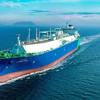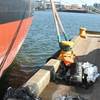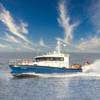Designers Aim for More Flexibility, Efficiency and Multi-mission Capabilities
By Larry Pearson
Four years into the new Millennium designers of workboats are incorporating new technologies and greater efficiencies into their designs to produce vessels that can do more work and do it better than designs of just a few years ago.
Supply Boats
This is very prevalent in the oil patch where today's supply boat designs emphasize more efficient vessels that can carry as much material to the rig or platform as vessels 30-40 ft. longer in years past.
"Our new 207 ft. supply vessels can carry over 6,000 barrels of liquid mud," said Robert Socha, marketing manager of Bollinger Shipyards, Lockport, La. "That is a key feature of these vessels that can work the new deeper gas wells on the shelf and also carry drilling liquids to the growing number of deepwater wells now in service," Socha added. The vessels also have two independent mud pumping and piping systems so different weights of mud can be carried or the vessel can perform "mud swaps"… removing old mud from a drilling rig and replacing it with new liquid mud. Operators such as MNM Boats, Golden Meadow, La. also like the stability of the 207-ft. supply boats. "We can go out in weather that would keep most vessels in port," said Albert Cheramie, of C & G Boats, the management company for MNM Boats.
"The boat is very stable and the 12-ft. high bulwarks keeps water off our crews working on the rear deck during bad weather," Cheramie added. Efficiency and sophisticated high tech went into the design of the 210- ft. supply boats for Rigdon Marine, Houston, Texas. Bender Shipbuilding and Repair, Mobile, Ala. is building 10 of these vessels with deliveries until spring 2005.
"To compete in today's marketplace, supply vessels have to have the flexibility to work on the shelf and in deepwater," said Larry Rigdon, president of Rigdon Marine. The vessels were designed by Guido Perla & Associates (GPA) of Seattle, Wash. "The foundation of these highly efficient vessels is its diesel electric power plant," said Dave Pasciuti, president of GPA. "This type of propulsion brings flexibility to the internal arrangements of the ship and optimizes internal capacities, " Pasciuti added.
The propulsion plant consists of a pair of Cummins QSK engines and a Cummins KT-38 engine connected to generators producing a total of 4,560 kW of electricity to drive a pair of Steerprop 20 Z-drives and two Berg 746 kW bow thrusters.
The vessels feature an Alstom DP-2 system and an Alstom Power Management System that matches the vessel electrical demand with the supply produced by the generators.
Safety remains an overriding concern in the design of supply vessels. For example, GPA designed stair towers into the Rigdon vessels that extend form the engine room to the highest deck on the vessel.
"The stair tower concentrates all staircases in the same vertical location of the vessel, thereby making it easy to access or escape from any level without having to locate the next staircase." Pasciuti said. A different design concept is very much evident in the new supply boats being built by Edison Chouest Offshore (ECO), Galliano La. Multi-mission capabilities and the economies that flow from this design are the major design driving force behind these vessels. "At 280 ft. long with a 60 ft. beam, these supply vessels are the longest ever built for offshore work," said Roger White, senior vice president at ECO.ECO has built five of these vessels and may eventually build eight or more. With the exception of the Amber, all of these vessels are on contract with Shell Oil Company.
"The 280-ft. supply boats evolved from the 260-ft. series we built a few years ago," White said. The longer vessels have 15,880 barrels of liquid mud capacity, 359,000 gallons of fuel oil and a clear deck area of 10,251 square ft…at least 20 percent more capacity that the 260-ft. series. Extra tankage is onboard for methanol or other types of liquid cargos.
"Our customer for these vessels…Shell Oil… likes the ability to serve more than one platform on a trip and the ability to carry a variety of liquid cargos as well as material on the rear deck….up to 4,830 deadweight tons of whatever is needed," White said. "Shell gets greater efficiency and operating cost savings using one of these vessels rather than two or three smaller supply boats," White replied. ECO is also a big believer in dynamic positioning. They formed a company, Marine Tech, to retrofit DP-2 systems on many of their supply boats. As of March 2004, ten such vessels have had the DP-2 upgrade and all new vessels such as the 280-ft. series have DP-2 installed in the shipyard.
The shifting needs of the oil companies are another major factor that drives design. Methanol is becoming more in demand on platforms as oil companies try to prevent freezing and formation of hydrates in flow lines, a common problem in deepwater installations. Carrying methanol is more dangerous that fuel oil, so special motors, pumps, tanks, piping and personnel handling gear are employed to safely transfer this volatile liquid. ECO added a 40-ft. midbody to one of their existing supply boats just to carry methanol and other vessels have been designed with the capabilities to carry this and other liquids that require special handling.
Crew/Supply Vessels
Crew/supply boats are also evolving in their design with more sophisticated systems and larger hull designs. "Most of the crew/supply vessels being built today are in the 175-ft. range in length with others only 10 ft. or so shorter," said Jerry Hoffpauir, general manager of Conrad Aluminum LLC, Amelia, La. a Conrad Industries Company.
The increased size of crew/supply boats is directly related to the oil companies needs for more cargo and liquids delivered faster than via supply boat. "The term 'Fast Supply Boat' is being given to these super sized all-aluminum vessels, emphasing the increased importance of their supply role," Hoffpauir added. Right now Conrad Aluminum is building a 180-ft. crew/supply vessel for Diamond Industries, also of Amelia. The vessel also showcases other trends in crew/supply boat design including DP-1, drop-down bow thrusters and greater rear deck cargo capacity. The vessel also features water jet propulsion. Water jets aren't necessarily a trend since they have been around for years. Some vessel companies such as Diamond Industries have an all-water jet fleet while Norman McCall, president of the small boat division of Seacor Marine, has a 175-ft. crew/supply boat design that uses water jets with the rest of the fleet using propellers.
"Water jets tend to cost more yet they aren't subject to haul out due to bent shafts and props," Hoffpauir said. McCall also believes that under a full load, propellers perform better than water jets, so you pay your money and make your choices. Gulf Craft, Inc., Patterson, La. has built over 50 crew boats for McCall Boat Rentals and its successor company Seacor Marine. At this time they have a 175-ft. waterjet powered crew/supply boat scheduled for September delivery to Seacor. Four Cummins KT-38 engines power Hamilton water jets. A 180-ft. vessel using propellers, also for Seacor Marine, is scheduled for December delivery.
"Our customers want larger vessels with enhanced cargo carrying capabilities, "said Scotty Tibbs, controller of Gulf Craft. The passenger compartment has remained relatively steady at 65-80 seats over the years, so the growth in the hull size is so customers can put more cargo on the rear deck and more liquids in hull tanks," Tibbs added. Look for a complete review of crew/supply boat design trends and construction activity in the November issue of Marine News.
Pilot Boats
When it comes to the design and construction of pilot boats, the naval architecture team of C. Raymond Hunt of Boston and shipbuilder Gladding-Hearn, Somerset, Mass have made a specialty of supplying these all-aluminum vessels. At the present time, four of these vessels are under construction for Portland, Ore. and Delaware pilots plus two for Louisiana.
From a design standpoint, it is a new contract for the Galtex Pilots in Galveston, Tex. that is unique. Gladding-Hearn is building their first water jet powered pilot vessel. "Water jets were selected over traditional propeller-driven craft to avoid costly repairs and down time due to damaged props and shafts from harbor debris," said Peter Duclos, president of Gladding Hearn.
The 70 by 21-ft. craft features a deep-V hull with high dead rise to provide excellent handling at all speeds. Top speed is expected to be 30 knots, according to Duclos. A pair of Cummins KT-38-M2 engines rated at 1300 hp connects to Hamilton 571 water jets via Reintjes gears.
Passenger Vessels
For the past several years the passenger vessel market has been driven by developments in the ferry industry. This year marked the first year that high-speed vessels carrying both passengers and vehicles debuted in the U.S. Two vessels are now running on the Great Lakes and one is on an Alaskan route.
Of all-aluminum design, these vessels feature high end interiors, quality seating, video entertainment and food service since the routes are two-hours plus in length even at the high speeds of 30+ knots.
"The market for these vessels is significant," according to Chris Pemberton, vice president of Austal USA in Mobile, Ala. Pemberton believes that now these high speed vessels are operating, others that may have been considering high speed passenger/auto service are taking a hard look at these vessels in light of the practical experience these three operators are accumulating.












